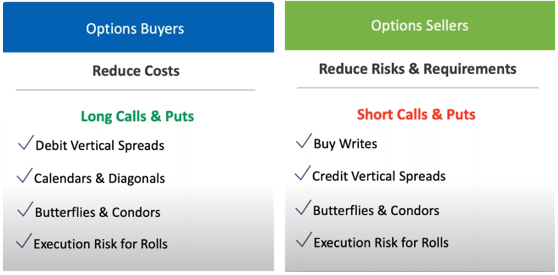Trading options involves selecting from a world of options, which may seem overwhelming at first. With 4 core strategies, buying calls, selling calls, buying puts and selling puts, it’s already a step up in complexity from stock investing and trading. Despite the flexibility that these strategies provide, each has their benefits and drawbacks. In this post, I will dive into the drawbacks of each strategy and how we can seek to minimize them by combining the four core strategies into multi-leg options strategies. We will seek to improve probabilities of success, reduce risks and even improve execution quality.
Buying Options
When we buy an option, they are by design, a limited risk instrument which allow investors to gain substantial upside exposure to a security but limit the maximum risk to the amount paid for the option contract. This may sound tempting, but the primary issue with buying options is that they are generally quite efficiently priced. The price paid for the options already reflects the expected move of the underlying security, considering the time to expiration and the expected volatility. This means, to profit from buying an option, not only do you need to get the direction correct, but the underlying security will also need to exceed the market’s expected volatility. For this reason, buying an outright call or a put option has a lower probability of success despite the theoretically unlimited profit potential.
Selling Options
On the other hand, selling an option has the exact opposite risk profile. In exchange for an upfront payment, the option seller takes on the obligation to buy/sell the stock to the buyer of the option at any time up to expiration at the agreed upon price. This obligation has significant risk. If the asset moves significantly against the expected trading range and direction, the risk is unlimited. In exchange for taking on this risk, the selling is compensated based on the market’s expected volatility. While this strategy has a very high probability of success, its poor potential risk/reward and unlimited risk nature makes it unsuitable for many investors.
What are Multi-Leg Options Strategies?
Multi-leg option strategies involve using two or more options in a single strategy and order. This combination of buying/selling call/put options at the same time allows for additional flexibility in the risk and rewards of each single leg strategy. They can allow for a more balanced risk profile and do not force investors to either take on unlimited risk, or a low probability of success. This is done by either reducing the cost to enter the trade or reducing the maximum risk or margin required to enter the trade. With this more balanced risk-profile, there are some tradeoffs as well, however, investors can seek strategies that have both limited risk and limited reward, without having to choose between the two.
Advantages of Multi-Leg Strategies
The benefits of utilizing multi-leg strategies are different for option buyers and option sellers. Multi-leg strategies allow option buyers to reduce the initial cost of the trade. This firstly reduces the total risk of the trade, but more importantly, increases the probability of success due to a reduced breakeven cost on the trade. For options sellers, multi-leg options strategies will significantly reduce the maximum risk and reduce the margin required to sell an option. In the example of selling a put option, the maximum risk per share is the strike price of the options contract minus the premium received and will be realized if the security declines to zero. Using a multi-leg strategy allows investors to limit the maximum risk and reduce the margin requirement of selling a naked call or put.
Table 1: Multi-Leg Options Benefits

Source: OptionsPlay
How can Multi-Leg Options improve my order execution?
From an execution perspective, multi-leg orders allow investors to eliminate execution risk of entering two separate trades to create a spread. If each leg’s orders are entered separately as two trades, there is a risk of one leg being executed while the other does not at the same time or at all. This creates an unbalanced position as the underlying stock can move significantly in the time it takes for the second order to get filled. Multi-leg orders ensure that both legs get filled at a single price and guarantees execution on both sides, thus eliminating an unbalanced position.
Additionally, multi-leg orders typically offer a better probability of execution at a fair price versus a single leg option. For the same reasons that multi-leg positions have reduced risk to the investor, a market maker who is creating liquidity on the trade also experiences reduced risks, and generally will be more willing to take on a multi-leg order over a single leg. In my experience of trading, market makers will typically execute a multi-leg order closer to the midpoint (fair value) than a single leg.
Summary
Using multi-leg option strategies allows for you to seek a more balanced risk to reward profile. This primary advantage comes from not being forced to either take on unlimited risk or unlimited reward, both of which have drawbacks. Whether you prefer to buy options to speculate on the directional view of an asset or sell an option to collect premium, multi-leg options strategies can help you reduce your overall risk. In addition, due to the defined risk nature of some multi-leg strategies, a reduction in margin requirements will provide capital efficiencies to your portfolio. Lastly, multi-leg options will eliminate unbalanced execution risk while also improving your probability of receiving an execution at a fair price.
Take advantage of free access to OptionsPlay Canada: www.optionsplay.com/tmx
—
Originally Posted on November 3, 2021 – Multi-Leg Options Can Reduce Risk & Improve Executions
Disclaimer:
The strategies presented in this blog are for information and training purposes only, and should not be interpreted as recommendations to buy or sell any security. As always, you should ensure that you are comfortable with the proposed scenarios and ready to assume all the risks before implementing an option strategy.
Copyright © 2021 Bourse de Montreal Inc. All rights reserved. Do not copy, distribute, sell or modify this document without Montreal Exchange’s prior written consent. This information is provided for information purposes only. The views, opinions and advice provided in this article reflect those of the individual author. This article is not endorsed by TMX Group or its affiliated companies. Neither TMX Group Limited nor any of its affiliated companies guarantees the completeness of the information contained in this article, and we are not responsible for any errors or omissions in or your use of, or reliance on, the information. This article is not intended to provide legal, accounting, tax, investment, financial or other advice and should not be relied upon for such advice. The information provided is not an invitation to purchase securities listed on Toronto Stock Exchange, TSX Venture Exchange and/or Montreal Exchange. TMX Group and its affiliated companies do not endorse or recommend any securities referenced in this publication. Toronto Stock Exchange, TSX, TMX, the TMX design, The Future is Yours to See., and Voir le futur. Réaliser l’avenir. are the trademarks of TSX Inc. and are used under license. Montreal Exchange and MX are the trademarks of Bourse de Montréal Inc. All other trademarks used herein are the property of their respective owners.
Disclosure: Montréal Exchange - Option Matters
This material is from Bourse de Montréal Inc. and is being posted with its permission. Opinions expressed in this document do not necessarily represent the views of Bourse de Montréal Inc.
This document is made available for general information purposes only. The information provided in this document, including financial and economic data, quotes and any analysis or interpretation thereof, is provided solely for information purposes and shall not be construed in any jurisdiction as providing any advice or recommendation with respect to the purchase or sale of any derivative instrument, underlying security or any other financial instrument or as providing legal, accounting, tax, financial or investment advice. Bourse de Montréal Inc. recommends that you consult your own advisors in accordance with your needs before making decision to take into account your particular investment objectives, financial situation and individual needs.
Although care has been taken in the preparation of this document, Bourse de Montréal Inc. and/or its affiliates do not guarantee the accuracy or completeness of the information contained in this document and reserve the right to amend or review, at any time and without prior notice, the content of this document.
Neither Bourse de Montréal Inc. nor any of its affiliates, directors, officers, employees or agents shall be liable for any damages, losses or costs incurred as a result of any errors or omissions in this document or of the use of or reliance upon any information appearing in this document.
Disclosure: Canadian Options Trading
Canadian Listed Options involve risk and are not suitable for all investors. Trading of certain standardized Canadian Listed Options may not be permitted for U.S. Residents. For more information read the Characteristics and Risks of Listed Canadian Standardized Options, also known as the options disclosure document (ODD). To receive a copy of the ODD call 877-745-4222 or copy and paste this link into your browser: https://www.cdcc.ca/f_en/Options_Disclosure.pdf
Disclosure: Interactive Brokers
Information posted on IBKR Campus that is provided by third-parties does NOT constitute a recommendation that you should contract for the services of that third party. Third-party participants who contribute to IBKR Campus are independent of Interactive Brokers and Interactive Brokers does not make any representations or warranties concerning the services offered, their past or future performance, or the accuracy of the information provided by the third party. Past performance is no guarantee of future results.
This material is from Montréal Exchange - Option Matters and is being posted with its permission. The views expressed in this material are solely those of the author and/or Montréal Exchange - Option Matters and Interactive Brokers is not endorsing or recommending any investment or trading discussed in the material. This material is not and should not be construed as an offer to buy or sell any security. It should not be construed as research or investment advice or a recommendation to buy, sell or hold any security or commodity. This material does not and is not intended to take into account the particular financial conditions, investment objectives or requirements of individual customers. Before acting on this material, you should consider whether it is suitable for your particular circumstances and, as necessary, seek professional advice.
Disclosure: Margin Trading
Trading on margin is only for sophisticated investors with high risk tolerance. You may lose more than your initial investment. For additional information regarding margin loan rates, see ibkr.com/interest
Disclosure: Options Trading
Options involve risk and are not suitable for all investors. Multiple leg strategies, including spreads, will incur multiple commission charges. For more information read the "Characteristics and Risks of Standardized Options" also known as the options disclosure document (ODD) or visit ibkr.com/occ




















